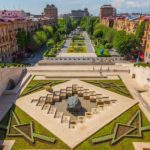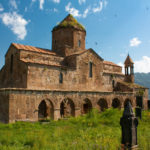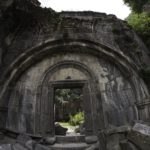According to historians, Great Armenia had 12 capitals, not including Tsopk (Sophene), Kammagene, Cilicia, Lesser Armenia (Armenia Minor) and other state units. However they insist that the Armenian statehood has deeper roots therefore, there were other capitals, about which we will know in the future. Before Yerevan, the following cities were capitals of Great Armenia:
Van
Van is situated on the shore of Lake Van. It is also known as Tosap, Tushpa, Van-Tosp. Yervandavan, Shamiramakert. It is one of the ancient cities of the world and many eminent archeologists were engaged in its excavations. Nowadays Van is a small provincial town in the east of Turkey.
Armavir
Armavir is situated nearby the village of Haykavan of Armavir district. Armavir was founded by Yervanduni dynasty”. In 331 BC, Armavir was declared the capital of Yervandini. After the Mongols’ invasions in the 13th century the city was abandoned. Centuries later the Armenians founded a new town, which was named Armavir in 1848.
Yervandashat
In 220 BC, King Yervand IV founded a city in Ararat district of Yeraskhadzor province on the spot of junction of the rivers Akhuryan and Araks. The citadel was walled with high gates; the entries were fortified with copper-wrought doors. In the IV century BC the city was completely destroyed by the army of the Persian king Shapuh II.
Artashat
Foreign historians witness that the place for the new capital was chosen by the commander of the Ancient Carthage, Hannibal, that’s why it is considered to be more likely that the city was founded in 189 BC. During the reign of King Tigran the Great, Artashat stayed far from the centre of the great state. In the 80s BC the capital city Tigranakert was founded. However, Artashat didn’t lose its beauty and flourished during the reign of King Artavazd II. Currently it is the centre of province.
Tigranakert
To rule the great state King Tigran the Great chose Antioch as a royal city. Artashat was rejected as it stayed away in the outskirts of the country, and the King wanted to see the capital of Great Armenia in Armenian lands. In the 80s BC, a new capital was founded in Aghdznik province, in the valley of the Kerkhe-a tributary of the Tigris. There were several cities bearing the name Tigranakert.
Vagharshapat
In IV BC, the son-in-law of Yervand Sakavakyats, Varges, founded the settlement of Vardkesavan which became a small town during the reign of Tigran the Great. King Vagharsh I (117-140) renamed the new capital into Vagharshapat. In 1945, Vagharshapat was renamed into Edchmiadzin and is the religious centre of Armenia.
Dvin
Dvin was one of the largest cities of those times. It is located not far from Artashat. The city used to be the centre of crafts. In 1227, Dvin was ruined by the army of commander Prosh, in 1236 it was captured by the Tatars. A number of small villages appeared in the place of the city.
Bagharan
Bagharan was located on the right bank of the Akhuryan River, in the province of Arsharunik. King Bagratuni turned it into the capital of Armenian state which brought back its independence as a result of long lasting struggle in 885. The city together with Yervandashat was founded by the last representative of the dynasty; Yervand IV. In 1934, it was ruined by the army of Tamerlane. Later Bagharan lost is significance and at the beginning of the 20th century there was an ordinary village with the population of 600 people.
Shirakavan
Smbat Bagratuni, reigned from 890 to 914, was crowned in 892 in the new capital of the country-Shirakavan (Yerazgavors). For nearly 40 years, during the reign of Smbat I and his son Ashot II the Iron, Shirakavban was the capital of Armenia. In 1920, the residents of Shirakavan were resettled, as a result of which some of them settled in Yerazgavors village of Akhuryan province.
Kars
Kars was first mentioned in the IX century, although it was founded earlier and from ancient times served as a capital city of the Nakharar’s house Vanand. In 1053, the army of Togrul-bek invaded Kars. Though the Kars Kingdom managed to keep its sovereignty for a while, in later years Kars passed from hands to hands. During the Turkish invasions the urban life, crafts and trade fell into decline. In 1828 Kars was conquered by the Russians, but in 1921 it was handed to Turkey. Nowadays Kars is a city in Turkey.
Ani
The history of Ani is proven not only with preserved cultural values but also with manuscripts. Legends about the city were handed down to us as well. At the beginning of the 10th century Ani was a well-known trade centre worth being a capital. Later, even while mentioning the Armenian kingdom of Bargatuni, the country was named Ani kingdom. Within 10-15 years often becoming the capital city, Ani got expanded and new gates were constructed.
In the 16th century Ani is already mentioned as a village. At the beginning of the 20th century excavations were carried out in this area. Today it is one of the sights of Turkey.


.png)






